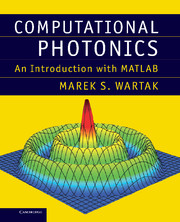Book contents
- Frontmatter
- Contents
- Preface
- 1 Introduction
- 2 Basic facts about optics
- 3 Basic facts from electromagnetism
- 4 Slab waveguides
- 5 Linear optical fibre and signal degradation
- 6 Propagation of linear pulses
- 7 Optical sources
- 8 Optical amplifiers and EDFA
- 9 Semiconductor optical amplifiers (SOA)
- 10 Optical receivers
- 11 Finite difference time domain (FDTD) formulation
- 12 Beam propagation method (BPM)
- 13 Some wavelength division multiplexing (WDM) devices
- 14 Optical link
- 15 Optical solitons
- 16 Solar cells
- 17 Metamaterials
- Appendix A Basic MATLAB
- Appendix B Summary of basic numerical methods
- Index
13 - Some wavelength division multiplexing (WDM) devices
Published online by Cambridge University Press: 05 July 2013
- Frontmatter
- Contents
- Preface
- 1 Introduction
- 2 Basic facts about optics
- 3 Basic facts from electromagnetism
- 4 Slab waveguides
- 5 Linear optical fibre and signal degradation
- 6 Propagation of linear pulses
- 7 Optical sources
- 8 Optical amplifiers and EDFA
- 9 Semiconductor optical amplifiers (SOA)
- 10 Optical receivers
- 11 Finite difference time domain (FDTD) formulation
- 12 Beam propagation method (BPM)
- 13 Some wavelength division multiplexing (WDM) devices
- 14 Optical link
- 15 Optical solitons
- 16 Solar cells
- 17 Metamaterials
- Appendix A Basic MATLAB
- Appendix B Summary of basic numerical methods
- Index
Summary
Wavelength division multiplexing (WDM) is a modern practical method of increasing transmission capacity in fibre communication systems. It uses the principle that optical beams with different wavelengths can propagate simultaneously over a single fibre without interfering with one another. In the wavelength range of 1280–1650 nm (like an All Wave fibre [1]) the useable bandwidth of a single mode fibre is about 53 THz. In recent years an improved (denser) WDM system known as DWDM is under development.
In this chapter we discuss some of the WDM devices and also provide some applications of BPM developed earlier to simulate those devices. We start by summarizing the basic WDM system.
Basics of WDM systems
WDM is the main technique used in the realization of all optical networks. WDM is the technology which combines a number of wavelengths onto the same fibre.
Key features include:
• capacity upgrade
• transparency (each optical channel can carry any transmission format)
• wavelength routing
• wavelength switching
Implementation of a typical WDM system employing N channels is shown in Fig. 13.1. In the shown system three wavelengths are multiplexed in one fibre to increase transmission capacity. The light of laser diodes with wavelengths recommended by the ITU is launched into the inputs of a wavelength multiplexer (MUX) where all wavelengths are combined and coupled into a single-mode fibre. When needed, propagating light can be amplified by an optical fibre amplifier and eventually imputed at the wavelength demultiplexer (DMUX) which separates all optical channels and sends them to different outputs.
- Type
- Chapter
- Information
- Computational PhotonicsAn Introduction with MATLAB, pp. 316 - 330Publisher: Cambridge University PressPrint publication year: 2013



